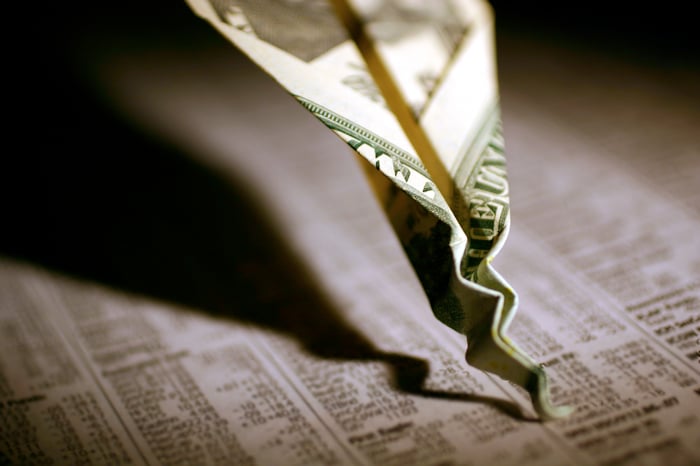As 2022 proved, things don't always go as planned on Wall Street. Following a year where seemingly nothing could go wrong for equities, the world-renowned Dow Jones Industrial Average (^DJI 0.20%), benchmark S&P 500 (^GSPC 0.14%), and growth-focused Nasdaq Composite (^IXIC 0.27%) all plunged into a bear market and respectively ended 2022 down 9%, 19%, and 33%. Collectively, this was Wall Street's worst performance since 2008.
What investors often overlook with stock market corrections and bear markets is that they're a completely normal and expected part of the long-term investing cycle. There have been 39 separate double-digit percentage stock corrections in the S&P 500 since the start of 1950. That's a meaningful downturn, on average, every 1.87 years.

Image source: Getty Images.
Despite the relative frequency of stock market corrections and bear markets, they can still be scary when they occur -- especially for new investors. The short-term volatility and uncertainty that accompany bear markets often have new and tenured investors alike asking one key question: When will the bear market end?
While calling bear market bottoms with any precision is pretty much impossible over the long run, there are economic indicators that offer clear clues as to where stocks are headed next, and one well-known leading indicator is offering an ominous warning for Wall Street.
This has only happened four times in 63 years
For the past 63 years, Wall Street professionals and investors have monitored the Conference Board Leading Economic Index (LEI) as one of many tools that can help forecast a U.S. recession. Even though the U.S. economy and stock market don't move in tandem, stock market declines during bear markets have, historically, been magnified once a U.S. recession is declared. This is why knowing if or when a recession may occur can be so valuable for investors.
The LEI is comprised of 10 components and reported as a six-month annualized growth rate, relative to the comparable period in the previous year. Three of its 10 components have financial ties, such as the S&P 500 index and the interest rate spread between 10-year Treasury bonds less the federal funds rate. The remaining seven components are non-financial and include private housing building permits, average weekly initial unemployment insurance claims, and the ISM Index of New Orders, to name a few.
March marked 12 consecutive monthly declines for LEI, which has only been reached and/or exceeded during recessions that started in 1973, 1980, and 2007 ... last time it hit 12m mark was March 2008, which was when Bear Stearns collapsed pic.twitter.com/HpAee6IrE3
-- Liz Ann Sonders (@LizAnnSonders) April 21, 2023
What's particularly noteworthy about the LEI at the moment is its precipitous decline. As you can see in the tweet above by Charles Schwab Chief Investment Strategist Liz Ann Sonders, there have only been four instances since the beginning of 1960 when the Conference Board LEI has declined for 12 consecutive months. The previous three instances all led to U.S. recessions, and the fourth instance is ongoing. In March 2023, the LEI endured its 12th consecutive monthly decline.
However, the length of declines in the LEI isn't the only potential warning. Dating back more than six decades, a decline of 4% (or greater) in the LEI has, without fail, forecast a U.S. recession. With the LEI retracing by 4.2% in December, history would suggest a recession is quite likely.
The Fed and other indicators concur with the LEI
While nothing is cemented in stone on Wall Street, other clues do suggest the LEI is correct and a U.S. recession is likely to materialize in the not-too-distant future.
One of the strongest supporters of the LEI is none other than the Federal Reserve. The recently released minutes from the Federal Open Market Committee's March meeting show that the staff has modeled in the expectation of a "mild recession" later this year.
10 Year-3 Month Treasury Yield Spread data by YCharts. Gray areas denote U.S. recessions.
The Federal Reserve Bank of New York's recession-probability indicator also suggests there's a growing likelihood of a U.S. recession within the next 12 months. The NY Fed analyzes the spread (difference in yield) between the three-month and 10-year U.S. Treasury bonds. In a healthy economy, longer-maturing bonds should offer higher yields than shorter-dated bonds. When yields invert and short-dated bonds offer higher yields than longer-maturing bonds, it can be a sign of economic trouble.
Recently, the yield-curve inversion between the three-month and 10-year Treasury bond hit its highest level since 1981. Not surprisingly, the NY Fed's recession-probability indicator says there's a 57.77% chance of a recession being declared in the next 12 months. That's the highest probability of a recession, per the NY Fed's tool, in more than 40 years.
It's also worth pointing out that, according to Chief U.S. strategist Ed Clissold of independent research firm Ned Davis Research, no bear market has bottomed after World War II prior to a recession being declared by the eight-economist panel of the National Bureau of Economic Research. Of the 12 previous bear markets that have occurred after World War II, they've taken an average of 5.9 months to reach their respective bottoms once an official recession was declared.

Image source: Getty Images.
Long-term investors have nothing to worry about
While a confluence of data continues to point to the growing likelihood of weakness for the U.S. economy in the months/quarters to come, it's important for investors to recognize that recessions, like stock market corrections and bear markets, are perfectly normal.
One thing to understand about recessions is that they're usually short-lived. Every recession after World War II has lasted just two to 18 months. By comparison, economic expansions, which allow corporate earnings to grow, are typically measured in years. Since bull markets last disproportionately longer than bear markets, and periods of economic expansion last considerably longer than recessions, it pays for investors to be optimistic.
To circle back to a datapoint I mentioned earlier, there have been 39 separate double-digit percentage declines in the S&P 500 since the beginning of 1950, per sell-side consultancy firm Yardeni Research. However, every single one of these downturns was eventually cleared away by a bull market rally, with the exception of the current bear market. History, once again, conclusively shows that it pays to be a long-term bull.
If the above isn't enough proof that now is as good a time as any to put your money to work on Wall Street, consider the data published annually by market analytics company Crestmont Research.
Crestmont analyzed the rolling 20-year total returns, including dividends paid, of the S&P 500 since 1900. The idea of its research was to see how much an individual would have, hypothetically, made or lost purchasing an S&P 500 tracking index and holding that position for 20 years. Out of the 104 ending years examined (1919-2022), all 104 produced a positive total return. In other words, it doesn't matter when you decide to put your money to work on Wall Street so long as you utilize time as an ally.





